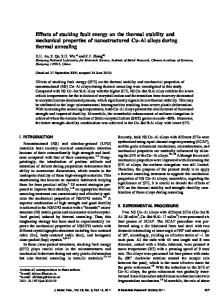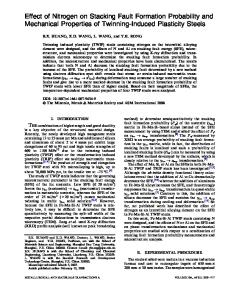Stacking Fault Energies, Crystal Elasticity and Their Relation to the Mechanical Properties of L1 2 -Ordered Alloys
- PDF / 326,847 Bytes
- 6 Pages / 420.48 x 639 pts Page_size
- 26 Downloads / 884 Views
STACKING FAULT ENERGIES, CRYSTAL ELASTICITY AND THEIR RELATION TO THE MECHANICAL PROPERTIES OF LI2 -ORDERED ALLOYS C. L. FU AND M. H. YOO Metals and Ceramics Division, Oak Ridge National Laboratory, P. 0. Box 2008, Oak Ridge, TN 37831-6114 ABSTRACT First-principles calculations of the stacking fault energies of NiAl, and the linear elastic constants of Ni2Al and Pt.Al are presented. The anomalous (positive) temperature dependence of flow stress in NI2Al and its absence in Pt2Al are fully rationalized in terms of the present results and cross-slip pinning mechanism. It is found that the elastic shear anisotropy factor plays an equally (or even more) important role than the anisotropy of antiphase-phase boundary energy in determining the plastic flow behavior of L12 -ordered alloys. INTRODUCTION One of the remarkable features of plastic deformation of certain intermetallic compounds with the L12 structure Is the anomalous increase in the flow stress with increasing temperature' (e.g., NiX with X = Al, Ga, Si, and Ge). A widely accepted model for interpreting the anomalous yield behavior is based on the cross-slip pinning mechanism, 2 -4 i.e., mobil dislocations of the (111)[T01] primary slip are pinned by segments which have cross-slipped to the (010) plane. The physical mechanism behind the crossslipping is believed to be the anisotropy of antiphase boundary (APB) energy - the APB energy on (010) plane is lower than on (111) plane and, furthermore, the (010) plane is not a active slip plane at low temperature. As the sessile configuration of the screw on the (010) plane becomes pronounced by thermal activation, the yield stress increases with increasing temperature. Yet, another class of L12 alloys also exists in which the anomalous flow behavior is either absent or relatively weak, and the flow stress increases with decreasing temperature in the low-temperature regime. A negative temperature dependence of flow stress 5 of this type has been observed in several platinum-based L12 alloys, such as Pt 3X with X = Al, Ge, and In. To interpret the anomalous yield behavior of L12 alloys, Yooo proposed that the effect of elastic anisotropy on the temperature dependence of yield stress is as important as the anisotropy of APB energy in describing dynamical breakaway of superpartial screw dislocations from cross-slipped segments. The purpose of this paper is to determine (1)the stacking fault energies of Ni2Al, and (2) the elastic constants of Ni2Al and Pt2Al using the first-principles full-potential linearized augmented plane wave (FLAPW) total energy method. 7 The contrasting mechanical behavior of Ni2Al and Pt 2Al is then explained in terms of using the cross-slip pinning model, the calculated APB anisotropy and elastic shear anisotropy.' CROSS-SLIP MODEL Let Wbe the distance which the dislocation segment cross slips on the (010) plane (W/r Y• ,(5)
for the APB-type dissociation. Note that, for Ni3Al, the APB energy anisotropy factor (
Data Loading...











